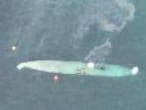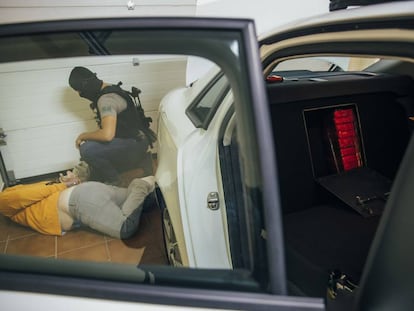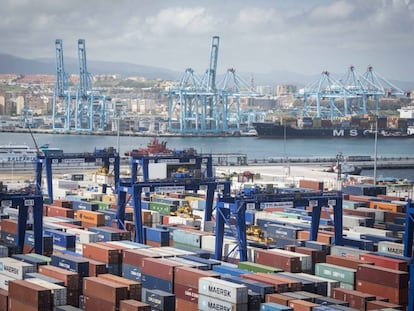Europe’s first ‘narco-submarine’ caught off Spain with 3,000 kilos of cocaine
Two crew members were arrested and a third got away during the joint operation on Sunday in the northwestern Galicia region


For Spanish narcotics officers, it had become something of a legend. But this past weekend, the legend became a reality.
On Sunday, the authorities intercepted the first “narco-submarine” ever caught in European waters. The vessel was seized off the coast of Pontevedra, in Spain’s northwestern Galicia region. It was carrying more than 3,000 kilograms of high-quality cocaine, according to sources familiar with the investigation.
Just the submarine itself must have cost around €2.5 million, said investigators
These sources added that the groups behind this shipment must be “big, since just the submarine itself must have cost around €2.5 million.”
The 22-meter-long submersible vessel had made the ocean journey from Colombia. Two crew members, both from Ecuador, were arrested by a joint team from the Spanish National Police, the Civil Guard and the Coast Guard. A search is underway for a third individual who escaped.
The stories about the existence in European waters of “narco-submarines such as the ones operating in the Pacific” had turned into something of a legend for Spanish narcotics officers. Since 2006, they had been hearing about drug-laden semi-submersibles making the trip to Spain and Africa. But no one had ever caught one.
An international tip-off put investigators on the trail
An international tip-off put investigators on the trail of a submarine carrying 3,000 kilos of cocaine from Colombia to Galicia, a region with a long history of drug-smuggling activity.
The vessel was intercepted off the coast of Aldán, within the municipal bounds of Cangas do Morrazo, in Pontevedra province. The same sources said that the submarine was made in Guyana in South America, and had been in operation “for years.” It was able to make “at least two trips a year.”
The operation has put a new spotlight on the drug trade in Galicia, which had been hard hit by numerous raids against its leaders. “They’ve taken advantage of the recent silence and worked discreetly while attention was focused on southern Spain,” said an investigator. This source added that the submarine “probably works with two of the strongest drug-trafficking groups that still operate in Galicia.”
The existence of these vessels had become something of a legend for Spanish anti-narcotics officers
This is not the first time that anti-narcotics raids have targeted submarines. Pablo Escobar, the notorious Colombian drug lord, was said to own a remote-controlled, 11-meter submersible that he allegedly purchased from the Colombian army. The vessel was ultimately located in a river in the middle of the jungle.
Galicia has a long history as a drop-off point for drug shipments because of its curving coastline filled with secluded coves. The police have carried out numerous raids in the region.
In August 2006, a homemade narco-submarine was found in an estuary in Vigo, in Pontevedra province. It was loaded with fuel and the engine was turned on. Judicial authorities later handed down two-year prison sentences to six individuals for attempting to bring cocaine into Galicia.
English version by Susana Urra.
Tu suscripción se está usando en otro dispositivo
¿Quieres añadir otro usuario a tu suscripción?
Si continúas leyendo en este dispositivo, no se podrá leer en el otro.
FlechaTu suscripción se está usando en otro dispositivo y solo puedes acceder a EL PAÍS desde un dispositivo a la vez.
Si quieres compartir tu cuenta, cambia tu suscripción a la modalidad Premium, así podrás añadir otro usuario. Cada uno accederá con su propia cuenta de email, lo que os permitirá personalizar vuestra experiencia en EL PAÍS.
¿Tienes una suscripción de empresa? Accede aquí para contratar más cuentas.
En el caso de no saber quién está usando tu cuenta, te recomendamos cambiar tu contraseña aquí.
Si decides continuar compartiendo tu cuenta, este mensaje se mostrará en tu dispositivo y en el de la otra persona que está usando tu cuenta de forma indefinida, afectando a tu experiencia de lectura. Puedes consultar aquí los términos y condiciones de la suscripción digital.
More information
Archived In
Últimas noticias
Welcome to the post-religion era: The idea of Christianity as the absolute truth has become obsolete
‘I thought you would like it’: The risky sexual practice popularized by TV shows and TikTok
The digitalization of tourism: ‘They promise experiences and gave us the worst possible one’
Mexican peso defies uncertainty with forecasts of a new period of stability in 2026
Most viewed
- Sinaloa Cartel war is taking its toll on Los Chapitos
- Oona Chaplin: ‘I told James Cameron that I was living in a treehouse and starting a permaculture project with a friend’
- Reinhard Genzel, Nobel laureate in physics: ‘One-minute videos will never give you the truth’
- Why the price of coffee has skyrocketed: from Brazilian plantations to specialty coffee houses
- Silver prices are going crazy: This is what’s fueling the rally











































